南京医科大学807生理学04-06年(05年回忆版)真题
南京大学2005--2006学年生理学期末考试试题.
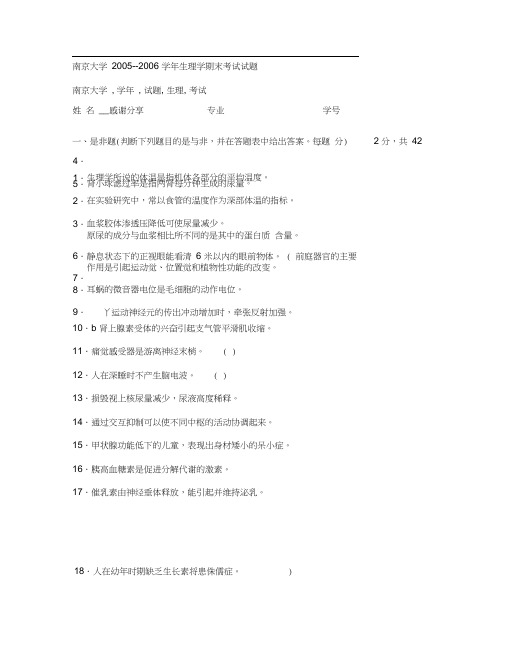
18.人在幼年时期缺乏生长素将患侏儒症。
)南京大学 2005--2006 学年生理学期末考试试题南京大学 , 学年 , 试题, 生理, 考试一、是非题(判断下列题目的是与非,并在答题表中给出答案。
每题 分)原尿的成分与血浆相比所不同的是其中的蛋白质 含量。
静息状态下的正视眼能看清 6 米以内的眼前物体。
( 前庭器官的主要作用是引起运动觉、位置觉和植物性功能的改变。
10.b 肾上腺素受体的兴奋引起支气管平滑肌收缩。
11.痛觉感受器是游离神经末梢。
( ) 12.人在深睡时不产生脑电波。
( )13.损毁视上核尿量减少,尿液高度稀释。
14.通过交互抑制可以使不同中枢的活动协调起来。
15.甲状腺功能低下的儿童,表现出身材矮小的呆小症。
16.胰高血糖素是促进分解代谢的激素。
17.催乳素由神经垂体释放,能引起并维持泌乳。
8.耳蜗的微音器电位是毛细胞的动作电位。
9.丫运动神经元的传出冲动增加时,牵张反射加强。
姓 名 __感谢分享专业 学号 2 分,共 42 1. 生理学所说的体温是指机体各部分的平均温度。
2.在实验研究中,常以食管的温度作为深部体温的指标。
3.血浆胶体渗透压降低可使尿量减少。
4.5.肾小球滤过率是指两肾每分钟生成的尿量。
6.7.19.促卵泡激素(FSH对睾丸生成精子无作用。
()20.在月经期,血液中雌激素和孕激素的浓度明显升高。
21.脊髓闰绍细胞构成的抑制被称为回返性抑制()二、选择题(每题的若干个选择答案中只有一个是正确的,请选择出正确的答案,并在答题表中给出答案。
每题2 分,共58分)1.环境温度高于皮肤温度时机体的散热方式是:A. 蒸发B. 传导C. 对流D. 辐射2.食物的氧热价是指:()A. A. 1g 食物氧化时所释放的能量B. B. 食物氧化时每消耗1L 氧所释放的能量C. C. 体外燃烧1g 食物所释放的能量D. D. 氧化1g 食物,消耗1L 氧时所释放的能量E. E. 食物氧化时,消耗1mol 氧时所释放的能量3.醛固酮可使肾小管:()A. Na +重吸收减少B. K +重吸收增加C. K +排出增加D. 水重吸收减少4.下列哪项与尿液的浓缩有关()A 肾髓质组织间液的高渗梯度B. 远曲小管和集合管对水的通透性C. 两者均无关D. 两者均有关5.下列哪种情况可导致肾小球滤过率增高:A. 由静脉快速注射大量生理盐水B. 由静脉快速注射大量高渗葡萄糖液C. 注射抗利尿激素D. 肾交感神经兴奋6.增加手上物体的重量会感觉到物体变重,这是因为:A. A. 传人神经纤维上的动作电位幅度变大B. B. 传人神经纤维上的动作电位频率增加C. C. 传入神经纤维上的动作电位波形改变D. D. 传人神经纤维上引起动作电位的阈值减小7.下列哪一项不是交感神经的作用:A. 心跳加快加强B. 皮肤血管收缩C. 支气管平滑肌收缩D. 促进肾上腺髓质分泌8.下列哪一项是感觉失语症的表现:A. 不会讲话B. 不会书写C. 看不懂文字D. 听不懂别人说话9.下列关于肌紧张的叙述,错误的是:A. A. 以屈肌的收缩活动为主B. B. 是缓慢持续牵拉肌腱时发生的牵张反射C. C. 是维持躯体姿势的最基本的反射活动D. D. 感受器为肌梭10.下列哪项不是兴奋性突触后电位的特征:A. A. 是由突触前膜释放兴奋性递质所引起的B. B.突触后膜主要对Na+的通透性增高C. C. 是突触后神经元的动作电位D. D. 电位可以总和11.下列关于非特异性投射系统的描述正确的是:A. A. 由丘脑的感觉接替核弥散地向大脑皮质投射B. B. 受到破坏时,动物进入持久的昏睡状态C. C. 向大脑皮质投射的区域狭窄,引起特定的感觉D. D. 受到刺激时,动物脑电图呈同步化慢波12.震颤麻痹的主要症状有 ( )A. 感觉迟钝B. 肌张力降低C. 意向性震颤D. 静止性震颤E. 意向性震颤13.下列关于胰岛素的叙述错误的是:A. 胰岛素使血糖水平升高B. 胰岛素是促进合成代谢的激素C. 血糖浓度升高时胰岛素分泌增加D. 迷走神经可促进胰岛素分泌14.影响神经系统发育的最重要的激素是:A. 生长素B. 甲状腺激素C. 肾上腺素D. 糖皮质激素15.下列哪一项不是甲状腺激素分泌过多的表现:A. 容易激动B. 血糖升高C. 心脏活动减弱D. 蛋白质分解加强两者都不对D. 两者都对17学号:201052311021分类号:D923 .下列关于生长素的描述,哪一项是错误的:硕士学位论文研究生姓名:李倩学科门类:法学专业名称:法律硕士(法学)学号:201052311021 分类号:D923 A.硕士学位论文论建筑物区分所有中的共有权研究生姓名:李倩学科门类:法学专业名称:法律硕士(法学)论文提交日期:2012年3月12日C. 可加速蛋白质的合成学位论文使用授权说明本人完全了解烟台大学关于收集、保存、使用学位论文的规定,即:按照学校要求提交学位论文的印刷本和电子版本;学校有权保存学位论文的印刷本和电子版,并提供目录检索与阅览服务;学校可以采用影印、缩印、数字化或其它复制手段保存论文;在非保密的论文范围内,学校可以公布论文的部分或全部内容。
05医学7年制生理学英文试题B卷
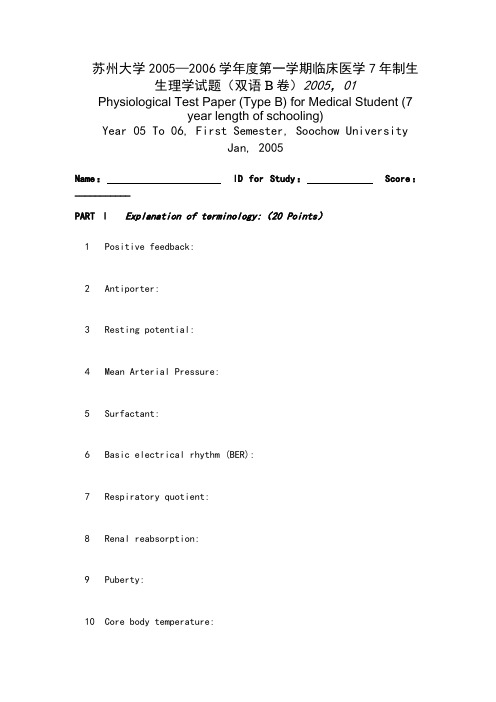
苏州大学2005—2006学年度第一学期临床医学7年制生生理学试题(双语B卷)2005,01Physiological Test Paper (Type B) for Medical Student (7year length of schooling)Year 05 To 06, First Semester, Soochow UniversityJan, 2005Name: ID for Study: Score:___________PART Ⅰ Explanation of terminology:(20 Points)1 Positive feedback:2 Antiporter:3 Resting potential:4 Mean Arterial Pressure:5 Surfactant:6Basic electrical rhythm (BER):7 Respiratory quotient:8 Renal reabsorption:9 Puberty:10 Core body temperature:PART ⅡSingle Choice: (30 Points, Please Make Your Answer in TABLE)1 What are specialized to produce force and movementA. muscle cellsB. connective tissuesC. nerve cellsD. epithelial cellsE. synapse2 The fluid environment surrounding each cell is called theA. intracellular fluidB. infracellular fluidC. internal environmentD. external environmentE. nuclear fluid3 How much of normal body weight is made up of waterA. 10%B. 35%C. 60%D. 90%E. 70%4 Which of the following is NOT a characteristic of lifeA. growthB. responsivenessC. reproductionD. organ systemsE. adaption5 Which of the following does NOT occur in a skeletal muscle during contractionA. thick and thin filaments bind to each otherB. musclefibers stretchC. thick and thin filaments “slide” past each otherD. muscle fibers shortenE. thick and thin filaments overlap6About the forming mechanism of action potential, ascending branch is due toA. Ca++ excurrent flowB. K+ incurrent flowC. Na+ excurrent flowD. K+ excurrent flowE. Na+ incurrent flow7 The random thermal motion of molecules from an area of higher concentration to oneof lower concentration is termedA. fluxB. diffusionC. osmosisD. bulk flowE. pump8 If the end-diastolic ventricular volumes are increased (within physiological limits)A. the stroke volume would be decreasedB. cardiac output would be decreasedC. venous pressure would be decreasedD. the force of cardiac contraction would be decreasedE. above-mentioned results would be incorrect9The maximum of ventricular pressure will occur inA. Period of isovolumetric contractionB. Period of atrium SystoleC. Period of ventricular ejectionD. Period of isovolumetric relaxationE. Period of ventricular filling10 A decrease in heart rate, with stroke volume and peripheral resistance held constant, will result in a decrease in all of the following, exceptA. arterial diastolic pressureB. arterial systolic pressureC. cardiac outputD. arterial pulse pressureE. mean arterial pressure11 Myocardial contractility is best correlated with the intracellular concentration ofA. Na+B. K+C. Ca++D. Cl-E. Mg++12 The greatest pressure drop in the circulation occurs across the arterioles becauseA. they have the greatest surface areaB. they have the greatest cross-sectional areaC. the velocity of blood flow through them is highestD. the velocity of blood flow through them is lowestE. they have the greatest resistance13 The most important chemical factor to stimulate respiratory excitation isA. HCO-3B. K++ D. CO2 E. O214 Correct description of the dead space does not includeA. dead space is the volume of air that does not reach areas of the lung where gas exchange occurs.B. anatomical dead space is due to the conduction airways.C. alveolar dead space is due to alveoli that receive inadequate blood flow.D. physiological dead space is the sum of anatomical and alveolar dead spaces.E. dead space volume is always changeable15 The most strong digestive liquid isA. salivaB. gastric liquidC. pancreatic liquidD. bileE. small intestinal liquid16 The function of intrinsic factor is to helpA. Digestion and absorption of Vitamin DB. Digestion and absorption of Vitamin CC. Digestion and absorption of Vitamin AD. Digestion and absorption of Vitamin EE. Digestion and absorption of Vitamin B1217 The most effective component of bile isA. bile acidsB. phospholipidsC. cholesterolD. PigmentsE. electrolytes18 The quickest stomach emptying isA. WaterB. carbohydrateC. proteinsD. fatsE. ions19 The primary site for digestion and absorption of food isA. esophagusB. stomachC. small intestineD. colonE. mouth20The most important excretive organ isA. lungB. kidneyC. skin tract E. breast21 The highest percentage of glomerular filtrate reabsorption occurs inA. Bowman’s capsuleB. proximal tubuleC. ascending limb of loop of HenleD. distal tubuleE. collecting duct22 The kidney “handles” K+ byA. filtration onlyB. filtration and reabsorption onlyC. filtration and secretion onlyD. filtration, reabsorption, and secretionE. filtration, reabsorption, and metabolism23 Pygmy, may be, in the childhood resulted from deficiency ofA. growth hormoneB. T3C. CortisolD. insulinE. Aldosterone24 Cretinism, may be, in the childhood resulted from deficiency ofA. growth hormoneB. T3C. epinephrineD. oxytocinE. glucagon25 Following hormone may elevate blood glucose concentration, exceptA. epinephrineB. glucagonsC. CortisolD. calcitoninE. growth hormone26 Blood from a marathon runner near the end of a race will contain all of the following, exceptA. decreased glucoseB. increased insulinC. increased glucagonsD. increased free fatty acidsE. increased glycerol27 Under the exercise condition, the most heat-producing tissue isA. musclesB. fatsC. liverD. bloodE. nerves28 Heat transfer occurs byA. radiationB. conductionC. convectionD. evaporationE. above-mentioned all29 The basic nervous centre for body temperature regulation isA. medulla oblongataB. pontine neuronsC. hypothalamusD. spinal cordE. brain cortex30 Aspirin can reduce fever becauseA. it directly depresses body temperatureB. it directly increases heat lossC. it directly decreases heat generationD. it directly reduces temperature set point in the hypothalamusE. it directly lets person take behavioural measures against fever PART Ⅲ Answer Question: (50 Points)1Please answer components of a typical ECG trace and each meaning. (8 Points)2 What are determinants and regulation of RBF (8 Points)3How are pulmonary ventilation Influenced by PO2 ,PCO2 , and pH (10 Points)4 What are typical and common patterns of motility in different parts of gastrointestinal tracts (8 Points)5 What are functions of thyroid hormones (8 Points)6 How does the human body’s reflex response to cold (8 Points)苏州大学2005—2006学年度第一学期临床医学7年制生生理学试题(双语B卷)2005,01 Physiological Test Paper (Type B) for Medical Student(7 year length of schooling)Year 05 To 06, First Semester, Soochow UniversityJan, 2005ANSWERPART Ⅰ Explanation of terminology:(20 Points)1 Positive feedback: There are situations where the initial response produces further change in the same condition. This is self-perpetuating and is called positive feedback.2 Antiporter: The carrier protein couples the movement of molecules in opposite directions, then it is called an antiporter and the molecules are said to be counter-transported.3 Resting potential: Under the quiet or calm conditions (without any stimuli), the membrane displays the potential difference between inside and outside the cell.4 Mean Arterial Pressure: MAP= Diastolic Pressure + 1/3 Pulse Pressure, about 100mmHg .5 Surfactant: The fluid lining the alveoli contains material, a phospholipid secreted by typeⅡ pneumocytes which lowers the surface tension of alveoli and cause surface tension to change with volume.6Basic electrical rhythm (BER): The basic electrical rhythm (BER) is a slow spontaneous depolarized wave in the GI tract and BER of smooth muscle cells form the basis (action potential) of stomach contractions.7 Respiratory quotient: RQ=Mol number of producing COin body2in body per unit time. per unit time / Mol number of consumptive O28 Renal reabsorption: Salt and water are reabsorbed in different parts of renal tubules into interstitial fluid and finally into the blood, which is named renal reabsorption.9 Puberty: Onset of the special periods is marked by pulsatile secretion of GnRH, FSH, and LH both in male and female for body fast development.10 Core body temperature: It is the temperature of the interior of the body and is a controlled variable that is maintained within narrow limits.PART ⅡSingle Choice: (30 Points, Please Make Your Answer in TABLE)PART Ⅲ Answer Question: (50 Points)1Please answer components of a typical ECG trace and each meaning. (8 Points)Three major components of an ECG are P wave, QRS complex,T wave.P wave: atrial depolarizationQRS complex: depolarization of ventriclesT wave: repolarization of ventriclesPR interval is the interval from the beginning of atrial activationto the beginning of ventricular activation.QT interval is the required for ventricular depolarization and repolarization.2 What are determinants and regulation of RBF (8 Points)RBF is determined by systemic arterial blood pressure and renal vascular resistance.RBF demonstrates autoregulation.Autoregulation involves afferent not efferent arterioles. Autoregulation is explained either by the myogenic hypothesis or tubuloglomerular feedback.3How are pulmonary ventilation Influenced by PO2 ,PCO2 , and pH (10 Points)Two groups of chemoreceptors, medullary and peripheral, send afferent information to the medulla and influence the depth and rate of respiration.Medullary chemoreceptors are sensitive to pH and increase ventilation when pH falls.Peripheral chemoreceptors are sensitive to pH↓, PO2↓ , and PCO2↑,with PCO2being most effective.Sensitivity of the peripheral chemoreceptors is influenced by pH,.PO2 , and PCO2.4 What are typical and common patterns of motility in different parts of gastrointestinal tracts (8 Points)The common patterns of motility in different parts ofgastrointestinal tracts is peristalsis.The typical patterns of motility at stomach is receptive relaxation for store of food.The typical patterns of motility at small intestine is segmentation for turning food into smaller particles and helping absorption.The typical patterns of motility at large intestine is mass movement for pushing the contents in the colon into the next downstream segment.5 What are functions of thyroid hormones (8 Points)(1) Because T3acts by inducing DNA transcription, its effects on tissue are the result of protein synthesis, primarily the synthesis of enzymes.(2) Thyroid hormones are required for normal growth throughout life.(3) Thyroid hormones affect basal metabolic rate, metabolism, the cardiovascular system, and the nervous system.(4) Symptoms of thyroid hormone excess or deficiency can be predicted from their normal effect.6 How does the human body’s reflex response to cold (8 Points)When a fall in core body temperature is detected by the hypothalamus, the reflex compensation involves reducing heat loss and generating more heat by increasing metabolic rate and through shivering.(1) Objective of body is to reduce heat loss and increase heat production.(2) Reducing heat loss occurs by decreasing skin blood flow and through behavioral responses.(3) Increasing heat production occurs through metabolic effects of thyroxin and catecholamines as well as by shivering.(4) Sustained exposure to extreme cold depresses hypothalamic temperature control mechanism and produces dilation of skin vasculature.。
南医生理2004
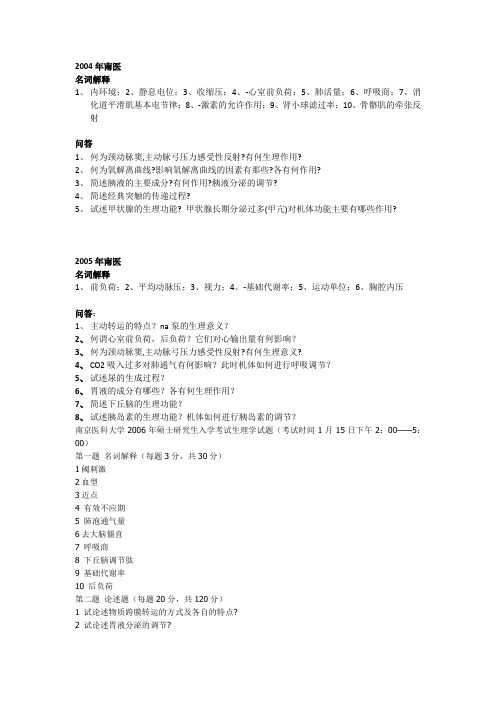
2004年南医名词解释1、内环境;2、静息电位;3、收缩压;4、-心室前负荷;5、肺活量;6、呼吸商;7、消化道平滑肌基本电节律;8、-激素的允许作用;9、肾小球滤过率;10、骨骼肌的牵张反射问答1、何为颈动脉窦,主动脉弓压力感受性反射?有何生理作用?2、何为氧解离曲线?影响氧解离曲线的因素有那些?各有何作用?3、简述胰液的主要成分?有何作用?胰液分泌的调节?4、简述经典突触的传递过程?5、试述甲状腺的生理功能? 甲状腺长期分泌过多(甲亢)对机体功能主要有哪些作用?2005年南医名词解释1、前负荷;2、平均动脉压;3、视力;4、-基础代谢率;5、运动单位;6、胸腔内压问答:1、主动转运的特点?na泵的生理意义?2、何谓心室前负荷,后负荷?它们对心输出量有何影响?3、何为颈动脉窦,主动脉弓压力感受性反射?有何生理意义?4、CO2吸入过多对肺通气有何影响?此时机体如何进行呼吸调节?5、试述尿的生成过程?6、胃液的成分有哪些?各有何生理作用?7、简述下丘脑的生理功能?8、试述胰岛素的生理功能?机体如何进行胰岛素的调节?南京医科大学2006年硕士研究生入学考试生理学试题(考试时间1月15日下午2:00——5:00)第一题名词解释(每题3分,共30分)1阈刺激2血型3近点4 有效不应期5 肺泡通气量6去大脑僵直7 呼吸商8 下丘脑调节肽9 基础代谢率10 后负荷第二题论述题(每题20分,共120分)1 试论述物质跨膜转运的方式及各自的特点?2 试论述胃液分泌的调节?3 试论述动脉血压是如何保持相对稳定的?如果切除家兔颈部双侧的减压神经,动脉血压如何变化?4 试论述突触传递的过程及特点?5 糖皮质激素的分泌是如何进行调节的?为什么长期服用激素的病人不能突然停药?6 试论述肾小管各段对水,钠离子,氯离子的重吸收过程?江苏大学医学院2005年生理学(硕士) & 一、名词解释(每小题3分,共30分)1.呼吸商2. EPSP3. 心动周期4. 旁分泌5. 易化扩散6.内因子7. CVP8. 肾糖阈9. 阈电位10. 氧饱和度二、简答题(每小题8分,共40分)1.简述去大脑僵直产生的机制。
南医大08年七年制生理试卷.
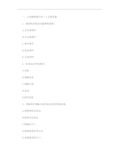
一、A型题每题只有1个正确答案:1、维持机体稳态的重要机制是(A.正反馈调节B.负反馈调节C.神经调节D.体液调节E. 自身调节2、机体的内环境是指A.体液B.细胞内液C.细胞外液D.血浆E.组织间液3、判断组织细胞兴奋性高低的常用指标是(A.刺激频率的高低B.阈电位的高低C.阈值的大小D.刺激强度的变化率E. 刺激强度的大小4、细胞膜内高K+的形成和维持是由于(A.安静时膜对K+的通透性大B.兴奋时膜对Na+的通透性大C.Na+的易化扩散D.Na+—K+泵的活动E. K+的易化扩散5、在细胞膜的物质转运中,Na+跨膜转运的方式是A.单纯扩散和易化扩散B.单纯扩散和主动转运C.易化扩散和主动转运D.易化扩散和出胞或入胞E.单纯扩散、易化扩散和主动转运6、能以不衰减的形式沿可兴奋细胞膜传导的电活动是A.静息膜电位B.锋电位C.终板电位D.感受器电位E.突触后电位7、完成骨骼肌收缩和舒张最基本的功能单位是(A.肌丝B.肌小节C.肌原纤维D.肌细胞E.横桥8、下列各物质作跨膜转运时,属于通道转运的物质是(A.Na+B.CO2C.NOD.葡萄糖E.维生素B129、构成血浆晶体渗透压的主要物质是(A.白蛋白B.球蛋白C.纤维蛋白原D.NaClE.KHCO310、当标准B血型的人作为供血者,而交叉配血出现主侧凝集、次侧不凝集时,受血者的血型应为(A.A型B.B型C.AB型D.O型E.上述现象不可能发生11、草酸盐和柠檬酸钠的抗凝原理是(A.阻止凝血酶原激活物的形成B.抑制血小板的聚集C.使凝血酶失活D.去除血浆中的Ca2+E.激活纤溶酶12、下列选项中,能有效刺激促红细胞生成素血浆含量增加的是A、缺02, B.C02滞留 C、雌激素D.肾脏疾患E.再生障碍性贫血13、纤维蛋白降解产物的主要作用是A、促进凝血酶的活性B.防止血小板的激活C、对抗血液凝固D.促进纤维蛋白单体聚合E.抑制纤维蛋白溶解14、动脉舒张压的高低主要反映(A.搏出量的多少B.心率的快慢C.外周阻力的大小D.大动脉弹性的好坏E.血容量高低15、心动周期中引起心室血液充盈的主要因素是(A.心房收缩B.静脉回流C.血流惯性D.心室舒张E.吸气运动16、生理学中所指的缓冲神经是(A.心交感神经B.窦神经和迷走神经C.心交感和交感缩血管神经D.交感和副交感舒血管神经E.心迷走神经17、高血压患者与正常人相比,下列哪项指标明显增高?A.每搏输出量B.射血分数C.心输出量D.心指数E.心脏做功量18、在微循环中,下列哪种结构主要受局部代谢产物的调节?A.微动脉B.微静脉C.通血毛细血管D.毛细血管前括约肌E.真毛细血管19、心细胞有效不应期特别长的生理意义是A.使心肌不发生强直性收缩B.使心肌“全或无”式收缩C.使心肌收缩更有力D.使心肌产生自动节律性兴奋E. 使心肌同步收缩20、平静呼气末仍留在肺内的气体量是(A.残气量B.功能残气量C.潮气量D.补呼气量E.用力呼气量21、血液PO2在8.0~13.3kPa(60~100mmHg之间变动时,Hb氧饱和度变化幅度较小,这有利于(A.剧烈运动时不致于CO2潴留B.高原生活不致于缺氧C.安静时向组织的供氧D.组织代谢增强时的供氧E.组织缺氧时的供氧22、肺表面活性物质的基本作用(A.使肺泡趋向于缩小B.增加肺泡表面张力C.降低肺泡表面张力D.增加毛细血管滤过E.降低气道阻力23、下列关于通气/血流比值的叙述,正确的是A.指肺通气量和肺血流量的比值B.人体平卧时,平均比值等于0.64C.人体直立时,肺尖部的比值减小D.比值增大意味着肺泡无效腔减小E.比值无论增大或减小,都不利于肺换气24、下列哪项能使氧解离曲线发生右移?A.糖酵解加强B.温度降低C•pH升高 D.CO2分压降低E.CO中毒25、缺氧引起呼吸活动增强主要是由于刺激了(A.颈动脉窦、主动脉弓压力感受器B.颈动脉体、主动脉体化学感受器C.中枢化学感受器D.延髓呼吸中枢E.中枢和外周化学感受器26、乙酰胆碱与M受体结合后,出现(A.骨骼肌血管舒张B.支气管平滑肌舒张C.胃肠道平滑肌舒张D.瞳孔括约肌舒张E.汗液分泌减少27、下列关于胃液分泌调节的叙述,正确的是A.头期调节属于纯神经反射B.胃期调节包括神经长、短反射和体液调节C.迷走神经引起的胃泌素释放可被阿托品阻断D.肠期调节约占进食分泌总量的30%以上.E.三个时期的分泌是顺序发生,互不重叠的28、胰泌素引起胰腺分泌胰液的特点是A、水和HCO3—多,酶少 B.水和HCO3—少,酶多C.水多,HCO3—和酶少D.水、HCO3—和酶都少E.水、HCO3—和酶都多29、下列物质中,食物的特殊动力作用最强的是A.糖B.脂肪C.蛋白质D.维生素E.无机盐30、发热开始前,先出现寒战的原因是A、人身体特别虚弱 B.体温调节中枢功能障碍C.机体过度散热D.机体产热量不足E.体温调定点上移31、与正常女性基础体温月周期节律相关的主要激素为(A.甲状腺激素B.雌激素C.孕激素D.生长素E.肾上腺糖皮质激素32、给家兔静脉注入20% 葡萄糖5ml后,引起尿量增加的原因是(A.肾小球有效滤过压增高B.血浆渗透压增高C.肾小管液渗透压增高D.血容量增加E.ADH释放减少33、分泌肾素的细胞是(A.球旁细胞B.致密斑细胞C.间质细胞D.肾小球血管内皮细胞E.球外系膜细胞34、在肾近端小管前半段,能被完全重吸收的物质是(A.Na+B.葡萄糖C.K+D.HCO3—E.Cl—35、下列关于正常人眼调节的叙述,正确的是A、视远物时需调节才能清晰成像于视网膜B.晶状体变凸有助于消除球面像差和色像差C.瞳孔缩小可避免强光对视网膜的有害刺激D.双眼球会聚可避免复视而形成单视视觉E.调节能力随年龄的增长而得到加强36、声波传入内耳最主要的途径是A、颅骨颞骨中耳蜗内淋巴B.外耳道鼓膜听骨链卵圆窗膜耳蜗C.外耳道鼓膜听骨链圆窗膜耳蜗D.外耳道鼓膜鼓室空气圆窗膜耳蜗E.外耳道鼓膜颞骨中耳蜗内淋巴37、耳蜗内电位是(A.内淋巴电位B.外淋巴电位C.微音器电位D.听神经动作电位E.感受器电位38、基底神经节损害的主要症状是(A.运动功能障碍B.内脏活动失调C.感觉功能障碍D.条件反射不能建立E.身体平衡功能失调39、属于类固醇激素的是(A.促甲状腺激素B.生长素C.甲状旁腺激素D.糖皮质激素E.卵泡刺激素40、关于突触前抑制的论述,正确的是(A.突触前膜超极化B.抑制性中间神经元兴奋C.兴奋性中间神经元抑制D.兴奋性突触后电位减小E.突触后膜超极化41、属于下丘脑调节性多肽的是(A.黄体生成素B.卵泡刺激素C.促甲状腺激素D.生长素释放激素E.催乳素42、安静清醒状态时的主要脑电波是(A.α波B.δ波C.0波D.β波E.棘波43、刺激交感神经可引起(A.胃肠运动增加,消化腺分泌抑制B.胃肠运动及消化腺分泌均抑制C.胃肠运动及消化腺分泌均增强D.胃肠运动抑制,消化腺分泌增强E.以上均不对44、在周围神经系统,毒蕈碱受体分布于A.自主神经节B.骨骼肌终板膜C.多数副交感神经支配的效应器D.多数交感神经支配的效应器E.消化管壁内神经丛所有的神经元45、人小脑绒球小结叶损伤后,将会出现下列哪种症状?A.站立不稳B.四肢乏力C.运动不协调D.静止性震颤E.意向性震颤46、呆小症是由于(A.幼年时生长素分泌不足B.胰岛素分泌不足C.糖皮质激素分泌不足D.幼年时甲状腺激素分泌不足E.糖皮质激素分泌增加47、糖尿病患者尿量增多的原因是A.饮水过多B.肾小球滤过率增高C.肾小管重吸收NaCl量减少D.小管液溶质浓度增高E.肾交感神经紧张度降低48、下列哪种激素是通过基因调节机制而发挥生物学效应的?A.肾上腺素B.心房钠尿肽C.胆囊收缩素D.甲状腺激素E.促肾上腺素皮质激素49、患者长期大量使用糖皮质激素时,下列哪种变化正确?A.血中CRH增加B.血中ACTH减少C.血中TSH增加D.血中GH减少E.血中PRL增加50、神经纤维在传导冲动时表现的基本特征之一为(A.幅度可变B.双向传导C.时间延搁D.容易疲劳E.节律改变B型题:1-6小题,每小题1分,共6分。
南京医科大学701生物综合历年考研真题汇编

第一部分 南京医科大学生物综合考研真题2008年南京医科大学生物综合(A卷)考研真题A卷 2008年南京医科大学硕士研究生入学考试试卷考试科目:生物综合说明:请将答案写在答题纸上,并请标清题号。
(答案写在试卷上一律无效)-------------------★------------------★-------------------★-----------------一、生理学部分1.下列生理过程中不属于正反馈的是______A.血液凝固过程 B.减压反射 C.排尿反射 D.分娩反射2.ACTHY引起糖皮质激素分泌增加属于______A.负反馈调节 B.体液调节 C.神经调节 D.自身调节3.对神经调节的特点叙述正确的是______A.调节范围小B.作用范围广,而且持久C.作用范围局限,而且反应较慢D.反应迅速、准确和短暂4.Na+通道突然大量开放的临界膜电位称为______ A.阈电位 B.阈值C.阈强度D.锋电位5.神经肌肉接头处兴奋传递的化学物质是______ A.去甲肾上腺素 B.肾上腺素C.5-羟色胺D.乙酰胆碱6.K+ 进入细胞内的方式______A.单纯扩散 B.易化扩散C.主动转运 D.继发性主动转运 E.入胞作用7.大多数可兴奋细胞受刺激时共有的表现是______ A.神经冲动 B.收缩C.感受器电位 D.产生动作电位8.在静息时,细胞膜内负外正的稳定状态是______A.极化 B.超极化 C.复极化D.去极化9.血浆胶体渗透压主要来自______A.脂类B.无机盐离子C.血浆蛋白D.氨基酸10.某人的红细胞与B型血的血清凝集,其血清与B型血的红细胞也凝集,此人血型为______A.A型B.B型C.AB型 D.O型11.影响红细胞内外水分正常分布的因素主要是______A.血浆胶体渗透压 B.血浆晶体渗透压C.组织液胶体渗透压D.毛细血管血压12.对交叉配血实验的叙述,错误的是______A.主侧指供血者与受血者血清相混合,次侧指供血者血清与受血者红细胞相混合B.对已知的同型血液输血,可不必做此实验C.主侧和次侧无凝集反应,可以输血D.主侧有凝集反应,不论次侧有无凝集反应,均不能输血13.下列哪项不是评定心功能的指标______A.心指数B.射血分数C.心输出量D.循环血量14.窦房结细胞0期除极化主要是______内流的结果A.Na+ B.K+ C.Cl- D.Ca2+15.心肌的异长自身调节是指心脏每搏输出量取决于______ A.平均动脉压的高低 B.交感神经的兴奋性、缺氧、中毒的影响C.心室舒张末期容积的大小D.心肌的后负荷16.心肌中自律性最高的是______细胞A.窦房结 B.房室交界C.浦肯野氏D.心室肌17.心室肌的前负荷是指______A.心室舒张末期容积或压力B.心室收缩末期容积或压力C.心室等容收缩末期容积或压力D.心室等容舒张末期容积或压力18.室性期前收缩之后出现代偿间歇的原因是______A.窦房节的节律性兴奋延迟发放B.窦房节的节律兴奋传出速度大大减慢C.窦房节的节律性兴奋少发放一次D.窦房节的一次节律性兴奋落在室性期前收缩的有效不应期中19.生成组织液的有效滤过压等于______A.(毛细血管血压+组织液胶体渗透压)—(血浆胶体渗透压+组织液静水压)B.(毛细血管血压+血浆胶体渗透压)—(组织液胶体渗透压+组织液静水压)C.(毛细血管血压+组织液静水压)—(毛细血管血压+组织液胶体渗透压)D.(血浆胶体渗透压+组织液胶体渗透压)—(毛细血管血压+组织液静水压)20.平静呼气末留存在肺内的含气量为______A.余气量B.残气量C.功能余气量D.呼气储备量21.肺泡表面活性物质减少将导致______A.吸气阻力增大B.肺弹性阻力减小C.肺顺应性增大 D.肺泡表面张力降低22.肺通气/血流比值过大,意味着______ A.肺泡无效腔增大B.解剖无效腔增大C.出现解剖动—静脉短路D.肺气体交换障碍23.迷走神经引起的胰液分泌特点是______ A.水分和碳酸盐含量很少,酶的含量却很丰富B.水分和碳酸盐含量很多,酶的含量却很低C.水分和碳酸盐含量很少,酶的含量亦低D.水分和碳酸盐含量很多,酶的含量亦很丰富24.支配消化道的副交感神经兴奋会引起______ A.胃液分泌减少 B.胃泌素分泌增加C.胃肠运动减弱 D.胆、胰分泌减少25.下列哪项不是胆汁的作用______A.作为乳化剂,降低脂肪的表面张力 B.分解脂肪为脂肪酸和甘油一酯C.促进脂溶性维生素的吸收 D.可中和一部分胃酸26.安静时产热量最大的器官是______A.骨骼肌 B.肺脏C.肝脏 D.脑27.大量饮清水后尿量增加的主要原因是______。
南京医科大学基础医学院807生理学历年考研真题专业课考试试题

2005年南京医科大学生理学考研真题 (回忆版)
2004年南京医科大学生理学考研真题
第二部分 相关院校生理学考研 真题
2016年中山大学909生理学考研真题
2012年南开大学856生理学(生科院)考 研真题
目 录
第一部分 南京医科大学生理学考研真题 2006年南京医科大学生理学考研真题 2005年南京医科大学生理学考研真题(回忆版) 2004年南京医科大学生理学考研真题
第二部分 相关院校生理学考研真题 2016年中山大学909生理学考研真Байду номын сангаас 2012年南开大学856生理学(生科院)考研真题
第一部分 南京医科大学生理学 考研真题
南京医科大学历年病生期末试题(全)
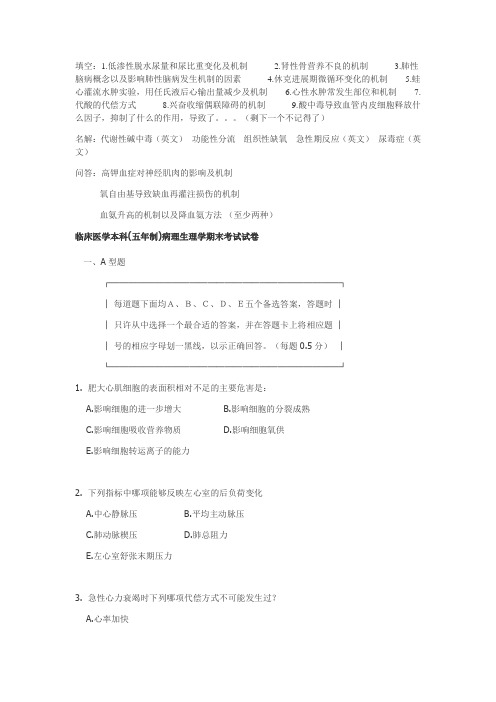
填空:1.低渗性脱水尿量和尿比重变化及机制 2.肾性骨营养不良的机制 3.肺性脑病概念以及影响肺性脑病发生机制的因素 4.休克进展期微循环变化的机制 5.蛙心灌流水肿实验,用任氏液后心输出量减少及机制 6.心性水肿常发生部位和机制7.代酸的代偿方式8.兴奋收缩偶联障碍的机制9.酸中毒导致血管内皮细胞释放什么因子,抑制了什么的作用,导致了。
(剩下一个不记得了)名解:代谢性碱中毒(英文)功能性分流组织性缺氧急性期反应(英文)尿毒症(英文)问答:高钾血症对神经肌肉的影响及机制氧自由基导致缺血再灌注损伤的机制血氨升高的机制以及降血氨方法(至少两种)临床医学本科(五年制)病理生理学期末考试试卷一、A型题┌──────────────────────────┐│每道题下面均A、B、C、D、E五个备选答案,答题时││只许从中选择一个最合适的答案,并在答题卡上将相应题││号的相应字母划一黑线,以示正确回答。
(每题0.5分)│└──────────────────────────┘1. 肥大心肌细胞的表面积相对不足的主要危害是:A.影响细胞的进一步增大B.影响细胞的分裂成熟C.影响细胞吸收营养物质D.影响细胞氧供E.影响细胞转运离子的能力2. 下列指标中哪项能够反映左心室的后负荷变化A.中心静脉压B.平均主动脉压C.肺动脉楔压D.肺总阻力E.左心室舒张末期压力3. 急性心力衰竭时下列哪项代偿方式不可能发生过?A.心率加快B.心脏紧张源性扩张C.交感神经兴奋D.心肌肥大E.血液重新分配4. 低输出量性心衰时下列哪种变化不可能发生A.外周血管阻力降低B.心肌收缩力减弱C.心室残余血量增多D.循环时间延长E.休息时心率加快5. 心肌肥大不平衡生长的组织学特征是A.毛细血管总数增多B.毛细血管间距减少C.闭合状态的毛细血管开放D.单位重量心肌毛细血管数减少E.以上都不是6. 下列指标中哪一项能够反映右心室的前负荷变化A.平均主动脉压B.肺动脉楔压C.右心室舒张末期压力D.左心室舒张末期压力E.心输出量第2页----------------------------------------------------------------------------7. 下列哪种措施可减少肠内氨生成A.利尿剂B.给氧C.酸灌肠D.输液E.补碱8. 哪种措施可使血氨降低A.慎用催眠、麻醉、镇静药B.左旋多巴C.高支链氨基酸溶液D.胰岛素E.新霉素9. 氨中毒时,脑内能量产生减少的另一机制是A.苹果酸穿梭系统障碍B.脂肪酸氧化不全C.酮体利用减少D.磷酸肌酸分解减慢E.糖酵解过程增强10. 肝性脑病时的假性神经递质是:A.苯乙胺B.酪胺酸C.羟苯乙醇胺D.血氨E.5-羟色胺11. 门体静脉吻合术后,血氨主要来自A.肝脏合成尿素不足B.肠道氨直接入血C.肌肉产氨增加D.尿PH降低,氨吸收入血增多E.肾脏氨排出减少12. 肝性脑病的正确概念是A.肝脏疾病并发的脑部疾病B.肝功能衰竭并发的脑水肿C.肝功能衰竭导致的精神神经综合征D.肝功能衰竭导致的精神紊乱E.肝功能衰竭导致的神经紊乱13. 人体内胆红素的70~80%是来自A.血红蛋白B.肌红蛋白C.细胞色素D.过氧化物酶E.过氧化氢酶第3页----------------------------------------------------------------------------14. 阻塞性通气不足,主要是由于A.肺顺应性降低B.肺泡通气血流比例失调C.非弹性阻力增加D.肺泡扩张受限制E.肺循环短路增加15. 关于通气/血流比值的变化,下述哪项正确A.阻塞性通气障碍比值升高B.限制性通气障碍比值升高C.肺内动静脉分流增加, 比值升高D.死腔通气时, 比值降低E.以上都不正确16. 肺能生成也能消除的血管活性物质是A.白三烯B.PGAC.组胺D.P物质E.肠血管活性肽17. 急性Ⅱ型呼吸衰竭患者血中二氧化碳增多主要表现为A.溶解的二氧化碳增加B.碳酸增加C.氨基甲酸血红蛋白增加D.血浆重碳酸盐增加E.红细胞内重碳酸盐增加18. 引起夜间阵发性呼吸困难的最关键因素是A.迷走神经兴奋性升高B.呼吸中枢抑制C.左心衰竭而右心功能尚好D.夜间肺淤血急剧加重E.冠状动脉血流减少,心功能下降19. 呼吸衰竭产生胃溃疡、胃出血的基本机制是:A.胃酸增多,胃粘膜屏障作用降低B.缺氧增强胃壁细胞碳酸酐酶活性C.二氧化碳潴留可使胃壁血管收缩D.缺氧使胃壁血管扩张,胃酸分泌增多E.以上全是第4页----------------------------------------------------------------------------20. 下列哪种表现属于症状A.心跳加快B.呼吸困难C.呼吸增快D.呼吸音增强E.咳泡沫样痰21. 疾病发生、发展的一个基本环节是A.稳态破坏B.因果转化C.损害反应D.抗损害反应E.损害和抗损害反应22. 下列哪种疾病与精神心理因素有关A.潜水员病B.缺血性心脏病C.消化性溃疡D.溃疡性结肠炎E.支气管哮喘23. 水和无机盐能从毛细血管动脉端滤出的主要原因是A.动脉端毛细血管通透性大B.动脉端血压大于血浆胶渗压C.血浆胶渗压大于血压D.组织胶渗压大于血浆胶渗压E.组织间液负压24.引起肾小球滤过分数升高常见于:A.肾髓质产生前列腺素A2增加B.肾皮质形成缓激酞增加C.充血性心力衰竭D.抗利尿激素分泌增加E.利钠激素生成增加25. 肾内“自由水”形成减少见于A.低血钙症B.低血容量C.低钠血症D.低钾血症E.低镁血症第5页----------------------------------------------------------------------------26. 尿崩症患者易出现A.高渗性脱水B.低渗性脱水C.等渗性脱水D.水中毒E.低钠血症27. 下述哪一项不是高钾血症所致的病理变化A.肌肉松弛无力B.心律失常C.T波高尖,Q-T间期缩短D.钾外流减慢,3期复极化时间延长E.心肌传导阻滞28. 钙反常发生的钙超载损伤与A.无钙期引起钙泵功能障碍有关B.细胞膜通透性增高有关C.复钙期钙浓度过高有关D.膜外板与糖被层表面分离有关E.缺氧后又给氧有关29. 心脏缺血再灌注损伤时血浆内乳酸脱氢酶(LDH)和肌酸磷酸激酶(CPK)含量变化为:A.增加B.降低C.先增加后降低D.先降低后增加E.不变30. 评价脑缺血再灌注损伤的主要代谢指标是A.ATP、CP及葡萄糖减少B.乳酸增多C.cAMP增多D.cGMP减少E.过氧化脂质生成增多31. 缺血/再灌注损伤最常见于A.心B.脑C.肺D.肾E.肠32. 缺血/再灌注损伤的防治措施不包括:A.抗炎以减轻白细胞积聚B.尽快恢复血流C.再灌注时低流、低压、低温D.改善缺血组织的代谢E.清除自由基第6页----------------------------------------------------------------------------33. 血浆鱼精蛋白副凝试验阳性说明A.血中凝血因子消耗B.Ⅻ因子被激活C.血中出现纤维蛋白降解产物D.组织凝血因子激活入血E.血中纤溶酶激活34. 弥散性血管内凝血患者发生出血的机制中,下列哪一项是错误的?A.凝血物质消耗B.FDP 释放增多C.FDP形成增多D.纤溶系统激活E.纤维蛋白原含量减少35. 弥散性血管内凝血病人发生出血时的治疗原则是A.立即给止血剂(如维生素K等)B.立即给抗凝剂(如肝素等)C.立即给纤溶抑制剂(如6-氨基乙酸等)D.立即去除病因,恢复凝血和纤溶的平衡(给肝素和新鲜血等)E.给抗凝血酶Ⅲ36. 全身Shwartzmen反应的本质是A.内毒素注射过量引起中毒性休克B.内毒素致敏引起过敏性休克C.内毒素注射引起DIC,发生微血栓、出血和休克D.内毒素抑制细胞代谢E.内毒素引起多个器官衰竭37. 下列哪一种物质不参与内源性凝血系统?A.激活的Ⅻ因子B.激活的Ⅹ因子C.血小板因子3D.Ⅴ因子E.组织因子38. Ⅻ因子激活后不会引起下列哪一种反应?A.激活纤溶系统,引起纤维蛋白溶解B.激活补体,引起细胞损伤C.启动内源性凝血途径引起微血栓形成D.启动外源性凝血途径引起微血栓形成E.激活激肽系统第7页----------------------------------------------------------------------------39. 标准碳酸氢盐和实际碳酸氢盐值均下降说明A.代谢性酸中毒B.呼吸性酸中毒C.代谢性酸中毒或代偿后呼吸性碱中毒D.代谢性酸中毒或代偿后呼吸性酸中毒E.代谢性酸中毒合并呼吸性酸中毒40. 对酸中毒的防治原则应首先注重A.积极防治原发性疾病B.改善肺功能C.防止水、电解质紊乱D.及时应用碱性药物E.以上全不是41.慢性呼吸性酸中毒时机体主要代偿方式是:A.细胞外液代偿B.呼吸代偿C.细胞内代偿D.肾脏代偿E.骨骼代偿42. 剧烈呕吐合并感染并有发热时,易引起A.呼吸性碱中毒+代谢性酸中毒B.代谢性碱中毒+呼吸性碱中毒C.代谢性碱中毒+呼吸性酸中毒D.呼吸性酸中毒+代谢性酸中毒E.代谢性碱中毒+代谢性酸中毒43.碳酸楚酐酶抑制剂大量应用易引起:A. AG正常型低氯性酸中毒B. AG正常型高氯性酸中毒C. AG增大型高氯性酸中毒D. AG增大型低氯性酸中毒E. AG减少型低氯性酸中毒第8页----------------------------------------------------------------------------44. 严重的心力衰竭患者发生酸碱平衡紊乱的类型A.乳酸增多的代谢性酸中毒B.酮体增多的代谢性酸中毒C.代谢性碱中毒D.呼吸性酸中毒E.呼吸性酸中毒合并代谢性碱中毒45. 临床上常把体温上升超过正常值的多少称为发热。
南京医科大学生理学2004年考博真题试卷
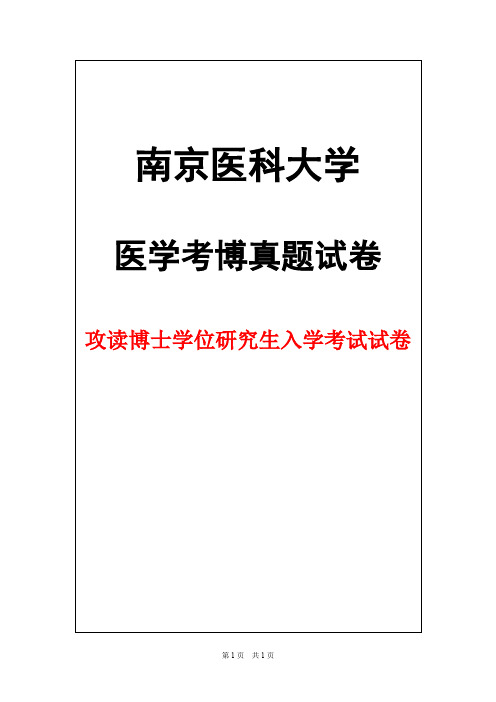
医学考博真题试卷
攻读博士学位研究生入学考试试卷
南京医科大学
2004年攻读博士学位研究生入学考试试题
考试科目:生理学
注意:所有答案一律写在答题纸上,写在试题纸上或其他地方一律不给分。
一、名词解释5分/个
内环境--静息电位--收缩压--心室前负荷--肺活量--呼吸商消化道平滑肌基本电节律--激素的允许作用--肾小球滤过率-骨骼肌的牵张反射
性反射有何生理作用
2:何为氧解离曲线影响氧解离曲线的因素有那些各有何作用
3:简述胰液的主要成分有何作用胰液分泌的调节
4:简述经典突触的传递过程
5:试述甲状腺的生理功能甲状腺长期分泌过多甲亢对机体功能主要有哪些作用
医学7年制生理学英文试题B卷
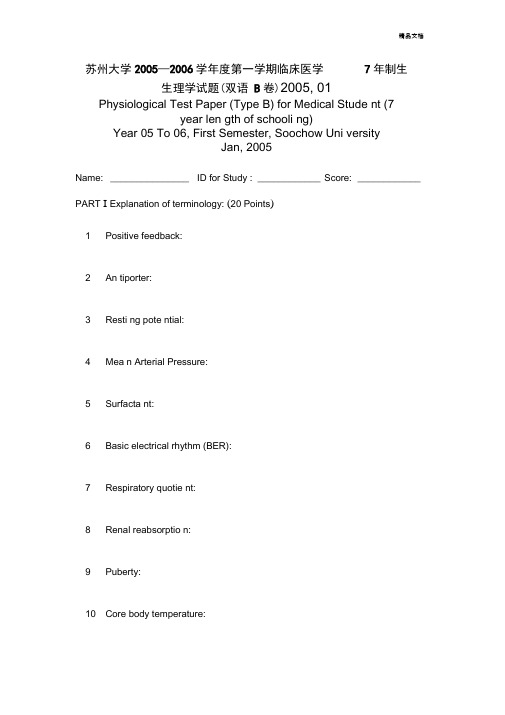
苏州大学2005—2006学年度第一学期临床医学7年制生生理学试题(双语B卷)2005, 01Physiological Test Paper (Type B) for Medical Stude nt (7year len gth of schooli ng)Year 05 To 06, First Semester, Soochow Uni versityJan, 2005Name: _______________ ID for Study : ____________ Score: ____________ PART I Explanation of terminology: (20 Points)1 Positive feedback:2 An tiporter:3 Resti ng pote ntial:4 Mea n Arterial Pressure:5 Surfacta nt:6 Basic electrical rhythm (BER):7 Respiratory quotie nt:8 Renal reabsorptio n:9 Puberty:10 Core body temperature:1 What are specialized to produce force and moveme nt?A. muscle cellsB. conn ective tissuesC. n erve cellsD. epithelial cellsE. syn apse2 The fluid environment surro unding each cell is called theA. i ntracellular fluidB. i nfracellular fluidC. i nternal en vir onmentD. exter nal environmentE. nu clear fluid3 How much of no rmal body weight is made up of water?A. 10%B. 35%C. 60%D. 90%E. 70%4 Which of the follow ing is NOT a characteristic of life?A. growthB. resp on sive nessC. reproducti onD. orga n systemsE. adapti on5 Which of the following does NOT occur in a skeletal muscle during con traction?A. thick and thin filaments bind to each otherB. muscle fibers stretchC. thick and thin filaments slide” past each otherD. muscle fibers shortenE. thick and thin filaments overlap6 About the forming mecha nism of action pote ntial, asce nding branch is due toA. Ca++ excurrent flowB. K+ incurrent flowC. Na+ excurrent flowD. K+ excurre nt flowE. Na+ i ncurre nt flow7 The ran dom thermal moti on of molecules from an area of higher concen trati on to oneof lower concen trati on is termedA. fluxB. diffusiC. osmosisD. bulk flowE. pumpon8 If the end-diastolic ventricular volumes are increased (within physiological limits)A. the stroke volume would be decreasedB. cardiac output would be decreasedC. venous pressure would be decreasedD. the force of cardiac contraction would be decreasedE. above-mentioned results would be incorrect9 The maximum of ventricular pressure will occur inA. Period of isovolumetric contractionB. Period of atrium SystoleC. Period of ventricular ejectionD. Period of isovolumetric relaxationE. Period of ventricular filling10 A decrease in heart rate, with stroke volume and peripheral resistance held constant,will result in a decrease in all of the following, except A. arterial diastolic pressure B.arterial systolic pressureC. cardiac outputD. arterial pulse pressureE. mean arterial pressure11 Myocardial contractility is best correlated with the intracellular concentration ofA. Na+B. K+C. Ca++D. Cl-E. Mg++12 The greatest pressure drop in the circulation occurs across the arterioles becauseA. they have the greatest surface areaB. they have the greatest cross-sectional areaC. the velocity of blood flow through them is highestD. the velocity of blood flow through them is lowestE. they have the greatest resistance13 The most important chemical factor to stimulate respiratory excitation isA. HCO-3B. K+C.H+D. CO2E. O214 Correct description of the dead space does not includeA. dead space is the volume of air that does not reach areas of the lung where gas exchangeoccurs.B. anatomical dead space is due to the conduction airways.C. alveolar dead space is due to alveoli that receive inadequate blood flow.D. physiological dead space is the sum of anatomical and alveolar dead spaces.E. dead space volume is always changeable15 The most strong digestive liquid isA. salivaB. gastric liquidC. pancreatic liquidD. bileE. small intestinal liquidThe function of intrinsic factor is to helpA.Digestion and absorption of Vitamin DB. Digestion and absorption of Vitamin CC. Digestion and absorption of Vitamin AD. Digestion and absorption of Vitamin EE. Digestion and absorption of Vitamin B 12The most effective component of bile is A.bile acids B. phospholipidsC. cholesterolD. PigmentsE. electrolytes The quickest stomach emptying is A.Water B. carbohydrateC. proteinsD. fatsE. ionsThe primary site for digestion and absorption of food isA. esophagusB. stomachC. small intestineD. colonE. mouth The most important excretive organ isA. lungB. kidneyC. skinD.GI tractE. breastThe highest percentage of glomerular filtrate reabsorption occurs inBowman 's capsule B. proximal tubuleC. ascending limb of loop of HenleA. D. distal tubule E. collecting ductThe kidney “handles ”K + by A.filtration onlyB. filtration and reabsorption onlyC. filtration and secretion onlyD. filtration, reabsorption, and secretionE. filtration, reabsorption, and metabolismPygmy, may be, in the childhood resulted from deficiency of A. growth hormone B. T 3 C. CortisolD. insulinE. AldosteroneCretinism, may be, in the childhood resulted from deficiency of A. growth hormone B. T 3 C. epinephrine D. oxytocinE. glucagonFollowing hormone may elevate blood glucose concentration, exceptA. epinephrineB. glucagonsC. CortisolD. calcitoninE. growth hormone Blood from a marathon runner near the end of a race will contain all of the following, except A.decreased glucose B. increased insulinC. increased glucagonsD. increased free fatty acidsE. increased glycerol16 17 18 19202122 23 24 252627 Under the exercise condition, the most heat-producing tissue isA. musclesB. fatsC. liverD. bloodE. nerves 28 Heat transfer occurs byA. radiationB. conductionC. convectionD. evaporationE. above-mentioned all29 The basic nervous centre for body temperature regulation isA. medulla oblongataB. pontine neuronsC. hypothalamusD. spinal cordE. brain cortex30 Aspirin can reduce fever becauseA. it directly depresses body temperatureB. it directly increases heat lossC. it directly decreases heat generationD. it directly reduces temperature set point in the hypothalamusE. it directly lets person take behavioural measures against feverPART 川Answer Question: (50 Points)1 Please answer components of a typical ECG trace and each meaning.(8 Points)2 What are determinants and regulation of RBF? (8 Points)3 How are pulmonary ventilation Influenced by PO 2 ,PCO2 , and pH? (10 Points)4 What are typical and common patterns of motility in different parts of gastrointestinal tracts? (8 Points)5 What are functions of thyroid hormones ? (8 Points)6 How does the human body's reflex response to cold? (8 Points)苏州大学2005—2006 学年度第一学期临床医学7 年制生生理学试题(双语 B 卷) 2005,01Physiological Test Paper (Type B) for Medical Student (7year length of schooling)Year 05 To 06, First Semester, Soochow UniversityJan, 2005ANSWERPART I Explanation of terminology: (20 Points)1 Positive feedback: There are situations where the initial response producesfurther change in the same condition. This is self-perpetuating and is calledpositive feedback.2 Antiporter: The carrier protein couples the movement of molecules in oppositedirections, then it is called anantiporter and the molecules are said to becounter-transported.3 Resting potential: Under the quiet or calm conditions (without any stimuli), themembrane displays the potential difference between inside anodutside the cell.4 Mean Arterial Pressure: MAP= Diastolic Pressure + 1/3 Pulse Pressure, about100mmHg (13.3kPa).5 Surfactant: The fluid lining the alveoli contains material, a phospholipidsecreted by type H pn eumocytes which lowers the surface tension of alveoliand cause surface tension to change with volume.6 Basic electrical rhythm (BER): The basic electrical rhythm (BER) is a slowspontaneous depolarized wave in the GI tract and BER of smooth muscle cells form the basis (action potential) of stomach contractions.7 Respiratory quotient: RQ=Mol number of producing CO2 in body per unit time /Mol number of consumptive O2 in body per unit time.8 Renal reabsorption: Salt and water are reabsorbed in different parts of renaltubules into interstitial fluid and finally into the blood, which is named renalreabsorption.9 Puberty: Onset of the special periods is marked by pulsatile secretion of GnRH,FSH, and LH both in male and female for body fast development.10 Core body temperature: It is the temperature of the interior of the body and is acon trolled variable that is main tai ned within n arrow limits.PART 川Answer Question: (50 Points)1 Please an swer comp onents of a typical ECG trace and each meanin g(8 Poin ts) Three major comp onents of an ECG are P wave, QRS complex" wave.P wave: atrial depolarizati onQRS complex: depolarizatio n of ven triclesT wave: repolarizati on of ven triclesPR in terval is the in terval from the beg inning of atrial activati on to the beg inning of ven tricular activati on.QT interval is the required for ventricular depolarization and repolarization.2 What are determi nants and regulation of RBF? (8 Poi nts)RBF is determ ined by systemic arterial blood pressure and renal vascular resista nee. RBF dem on strates autoregulatio n.Autoregulatio n invo Ives affere nt n ot effere nt arterioles.Autoregulatio n is expla ined either by the myoge nic hypothesis or tubuloglomerular feedback.3 How are pulmo nary ven tilation In flue need by PO 2 ,PCO2 , and pH? (10 Poi nts)Two groups of chemoreceptors, medullary and peripheral, send affere nt in formati on to the medulla and in flue nee the depth and rate of respirati on.Medullary chemoreceptors are sen sitive to pH and in crease ven tilatio n whe n pH falls. Peripheral chemoreceptors are sensitive to pH O2 J , and(P©2 f with PCO2 being most effective.Sen sitivity of the peripheral chemoreceptors is in flue need by pH,. PO, and PCQ.4 What are typical and common patterns of motility in different parts of gastrointestinal tracts? (8 Points)The common patterns of motility in different parts of gastrointestinal tracts is peristalsis.The typical patterns of motility at stomach is receptive relaxation for store of food.The typical patterns of motility at small intestine is segmentation for turning food into smaller particles and helping absorption.The typical patterns of motility at large intestine is mass movement for pushing the contents in the colon into the next downstream segment.5 What are functions of thyroid hormones ? (8 Points)(1) Because T3 acts by inducing DNA transcription, its effects on tissue are theresult of protein synthesis, primarily the synthesis of enzymes.(2) Thyroid hormones are required for normal growth throughout life.(3) Thyroid hormones affect basal metabolic rate, metabolism, the cardiovascularsystem, and the nervous system.(4) Symptoms of thyroid hormone excess or deficiency can be predicted fromtheir normal effect.6 How does the human body's reflex response to cold? (8 Points)When a fall in core body temperature is detected by the hypothalamus, the reflex compensation involves reducing heat loss and generating more heat by increasing metabolic rate and through shivering.(1) Objective of body is to reduce heat loss and increase heat production.(2) Reducing heat loss occurs by decreasing skin blood flow and throughbehavioral responses.(3) Increasing heat production occurs through metabolic effects of thyroxin andcatecholamines as well as by shivering.(4) Sustained exposure to extreme cold depresses hypothalamic temperaturecontrol mechanism and produces dilation of skin vasculature.。
